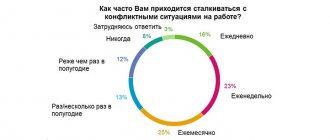Conflict situations occur not only between individuals.
Much more serious conflicts arise when entire states and millions of people are involved in the incident.
Many people do not fully understand what the danger of interethnic conflicts , how important it is to solve the problem peacefully, otherwise serious consequences are possible.
How to resolve internal conflict? Expert advice to help you!
Concept
A national conflict is a clash of interests and views between national-ethnic communities or their components.
In most cases this is the result of nationalism.
Interethnic conflict is a broader concept. This is a type of social conflict. There are many contradictions at its core.
Usually they are of a state, political, ethnosocial nature. Thousands and millions of people take part in such disputes. They are widespread and can last for years, decades.
If the parties stop hearing each other and try to prove that they are right, the situation becomes very complicated and can lead to military action .
That is why they try to solve such situations in the first stages, preventing their development.
Forms of conflicts
There are several basic civilized and uncivilized forms of conflict. This can be either discrimination based on nationality or religion, or open clashes leading to mass unrest and local wars. It is customary to distinguish the following forms and types of interethnic conflicts:
- local separatist and civil wars;
- mass riots with gross violation of individual rights;
- religious fundamentalism.
The latter is the most dangerous, since differences in religion often lead to mass riots and ethnic cleansing. Subsequently, solving such problems and reconciling warring nations can be extremely difficult, and often even impossible.
What are the causes?
Why do they arise? The causes of national and interethnic conflicts are slightly different. The first group includes the following factors:
- Ethnopsychological . Destruction of the usual way of cultural life, fear of losing established national values, rejection of new norms.
- Political . Different political leaders can have a certain influence on national communities, and this influence is not always positive. The impact can be very negative. There are cases in history when peoples were persecuted and discriminated against due to certain political actions.
- Socio-economic. If a certain ethnic society is criticized by society, its rights are infringed, this also affects the economic component of individuals. This infringement can lead to conflict.
- Cultural .
Conflicts occur due to cultural differences between certain ethnic groups that cannot accept the existence of these differences. Criticism and discrimination are an integral part of such a situation. Peoples cease to understand and hear each other; they try to prove that one ethnic group is better than another. Claims to cultural and traditional features are indicated, to which the opposition reacts especially emotionally.
The causes of interethnic conflicts include other factors:
- Geographical Disconformity .
Peoples are not happy with the establishment of territorial boundaries; the belonging of a territory to one or another ethnic group may be disputed. The situation becomes especially complicated if one territory once belonged to the first party, and after a certain time to the second. Then both peoples have the same rights and the fate of the territory becomes uncertain. - Social dissatisfaction . It can manifest itself both within one state and several at once.
- Story . In the past, there may have been contradictions and misunderstandings between certain peoples. Some issues may concern ethnic groups in the present, causing conflicts.
- Cultural and linguistic claims . Most often they happen due to the suppression of culture, the prohibition of a certain language.
- Natural resources . Different peoples can fight and war for them.
- Difference of religions . Commitment to one faith or another can become a real cause for conflict. A people can adhere to one religion and criticize another, imposing their views on their opponents.
Possible prerequisites
The success of resolving existing conflicts will largely depend on the correct determination of the cause of their occurrence . Most often, this is a serious deformation in national politics, as well as dissatisfaction with the situation of a nation or group of people that has accumulated over many decades. Sometimes even the slightest spark is enough for a bloody conflict to break out, which will be extremely difficult to resolve in the future.
Typically, interethnic conflicts manifest themselves against the backdrop of a deteriorating economic situation in the country; experts even provide graphs and tables of the direct relationship between the growth of tension and the state of households. This leads to social dissatisfaction when one group or nation receives certain privileges from the state, while another community is forced to endure the hardships and deprivations of poverty. A classic example of interethnic conflicts are wars in Africa, which arise against the background of a depressed economy and poverty of the population.
In post-Soviet countries, the causes of conflicts are the artificiality of creating separate states, the ossification of the governance structure, as well as the reluctance to see and solve problems that can lead to numerous national or ethnic clashes and general tension.
Another reason for the development of interethnic state conflicts is the historical factor. In the past, different ethnic groups could fight for territory and were dependent on each other, which led to restrictions on rights, infringement of national interests, traditions, culture and language. Today, when such nations find themselves in the conditions of one country and compact residence, historical relationships and past problems are not forgotten, they are gradually smoldering, and the slightest reason is enough for the development of a clash or even a full-scale war.
Types and examples of modern conflicts
There are national conflicts:
- Interethnic . This is a misunderstanding that occurs between representatives of ethnic communities. They live close to each other, in the same state.
- Ethno-confessional . Confessional differences aggravate ethnic ones, complicating the situation. It is clearly manifested in regions where several peoples live, each of which developed in a specific civilization.
- Ethnopolitical . Misunderstandings and clashes of views are associated with the politicization of an ethnic community.
- Ethnoconflict . This is a clash of views between representatives of different ethnic groups. Usually, contradictions are associated with the cultural characteristics of peoples and traditions.
A striking example is the dispute between Armenia and Azerbaijan over who owns Nagorno-Karabakh.
The territory has a rather interesting history and is of great importance for both states, so it has not been possible to resolve the dispute for many years .
Types of interethnic conflicts include:
- Conflicts of stereotypes . Ethnic groups do not understand the causes of contradictions, do not remember the true sources of disagreements, but people retain a negative image of this or that people.
- A clash of ideas. An ethnic group puts forward a certain proposal that is not supported by other ethnic groups and is even condemned.
- Misunderstandings based on certain actions . They are rallies, demonstrations, open expression of certain claims. Such measures can cause negative attitudes, criticism, and misunderstandings.
Interethnic conflicts in history are very common.
This is a struggle for resources, for territory .
An example is the Chechen conflict, when the issue of independence of Chechnya .
There were supporters of Chechnya's secession from Russia and supporters of its preservation within the country. Then different ethnic groups tried to prove that they were right, the need for independence, which is why the conflict occurred.
Read about ways to resolve intergroup conflicts here.
Local national and religious conflicts in the former USSR in the 1990s:
In Russia
Interethnic relations in the Russian Federation are a little tense. And there are a number of reasons for this.
- Russia has “depressed territories” with a huge percentage of unemployment. This is the North Caucasus.
- Migration. The local population does not like migrants because they believe that the economy within the country is deteriorating precisely because of them. Migrants are also seen as competition (in terms of work, housing, and so on).
- A huge part of the local population is not satisfied with the economic and social situation in the country. Because of this, people start looking for the culprits. Because of this, ethnic strife begins that is associated with the inhabitants of the Caucasus.
Ways to overcome and solutions
What is the conflict resolution plan? To overcome conflicts and resolve such situations, you need to hear each other. Negotiations and the conclusion of peace treaties are used.
Diplomats participate in negotiations and offer compromise solutions.
If the parties hear each other and respect opposition views, such situations will be resolved.
Experts believe that such situations must be stopped at an early stage in order to prevent war and loss of life.
It is necessary to prevent discrimination against the population , the infringement of this or that people, it is necessary to cultivate in citizens respect and love for other cultures, the desire to get to know each other, and not to show hatred.
Unity, the desire to understand each other, these are the components that help effectively prevent conflicts. Respect for each other's interests will help maintain peace .
Interethnic conflicts and ways to overcome:
In modern world
In the modern world, interethnic relations also manifest themselves. The best unification of several nations is the creation of a large multinational state.
It must take into account the interests of each nation. For example, Belgium. This country has several official languages:
In such a state, cultural pluralism is formed. With the formation of cultural pluralism, all nations preserve their culture, language and traditions without losing their identity. It is also possible for nations to complement each other, that is, each of them adopts something from the other.
Problems of interethnic conflicts: ways to solve them.
annotation
The current Russian Federation is a multinational state with a great and glorious history, the legal successor of the Russian Empire and the Soviet Union. From the moment the Eastern Slavs acquired statehood, various peoples sought the citizenship of Russian rulers. And since 862, our history has not known a single case of genocide by the Russian people of any other. On the contrary, Slavs, Finno-Ugrians, Jews, Turks, and the peoples of the Caucasus and Transcaucasia gathered around the throne of the Rurikovichs and Romanovs. Even many Western Europeans, for example, Franz Lefort, served the Russian Tsar. The double-headed eagle sheltered people of very different origins and cultures under its wing and did not offend anyone. Russian people, despite their desire to defend their native country and culture, are characterized by tolerance, understanding and a sense of camaraderie. In the best, not feigned sense of these words. Although the uninvited guests never got what they were after. With the expansion of the Russian state, many peoples joined it peacefully. The Moscow tsars acted wisely, not imposing their faith and culture, respecting the traditions and customs of their new subjects. Even Tsar Ivan IV the Terrible, having annexed Kazan and Astrakhan, did not take revenge for the past under Horde rule, and two centuries later, Grigory Potemkin, having put an end to the Crimean Khanate, did not deprive the Tatar nobility of privileges and impose Orthodoxy on the Crimeans. History knows a lot of examples that the Russian Empire was formed peacefully, without mass destruction or cultural conquest of a particular people. Even the Caucasian War of 1817-1864 ultimately ended in peace and symbiosis between the Russians and the peoples of the Caucasus to the present day. Finally, during the Great Patriotic War of 1941-1945. Without hesitation, all the peoples of the Soviet Union, with rare exceptions, repulsed the enemy.
As Dale Carnegie said: “Every nation considers itself superior to other nations. This gives rise to patriotism and... wars.”
This is exactly the situation that still exists. This work specifically addresses the problem of aggravation and emergence of interethnic conflicts. Particular attention is paid to the question: “What is the degree of understanding and tolerance towards these people?” At the moment, this problem has been little studied and requires further research.
Their main causes are also discussed. In addition, the historical roots of the problem of these conflicts have been clarified. One of the cases of clashes between representatives of different nationalities is given as an example. The idea is substantiated about what is the role of religion in this case? The question was posed: “What ways of resolving interethnic conflicts would you choose?” and a survey was conducted among students of the Odintsovo Gymnasium No. 7. The purpose of the work is to study this problem to identify ways to resolve interethnic conflicts.
Introduction
Currently, interethnic conflicts have become one of the most powerful dominants of social tension in Russia, where back in 1992 there were approximately 70 zones of potential interethnic conflicts, some of which by 1995 had led to casualties, and in Chechnya even to large-scale military actions. One can consider, in turn, the current conflict in the South-East of Ukraine as inter-ethnic. And all the current wars are in one way or another connected with the problem of national contradictions, for example, the war in Iraq, the civil war in the Syrian Arab Republic, the Kurdish crisis in Turkey. The list goes on and on.
In this regard, it is natural to raise the question of the reasons for the emergence of interethnic conflict in the territory of the former USSR and Russia. Russia is a multinational state. More than 190 peoples live on its territory. And, of course, each of us has encountered people belonging to a different nationality, a different religion, and holding different views.
It is very good if you come across people who can treat representatives of other nationalities kindly, but among them there are also those who disapprove of them and their residence in this country. The same rule applies to visitors. Among national minorities there are aggressive individuals who have hostility towards representatives of the titular nation. This combination is complemented by a depressingly low level of culture, everyday rudeness, and the mediocre quality of education. As a rule, ardent supporters of nationalism are representatives of the lower classes of society. Economic problems also add fuel to the fire: poverty, unemployment. This especially applies to the southern regions of the Russian Federation. As a result, all these factors can lead to dire and unpredictable consequences.
Relevance
The relevance of this topic lies in the fact that over the past 25 years, national conflicts have intensified. This is of greatest concern to Russian society, which has historically been tolerant.
Target
The purpose of the work is to study this problem to identify ways to suppress these conflicts and strengthen the unity of the Russian multinational people.
Object of study:
are the answers of Gymnasium student respondents from grades 7 to 10
Subject of research
is interethnic relations.
Considering the goal and subject, you can set yourself the following tasks:
1. Explore the main causes of interethnic conflicts;
2. Identify ways to resolve conflicts
Hypothesis
In any country, interethnic conflicts based on interpersonal relationships manifest themselves.
Problem
The problem is that in modern Russia, as well as in many other countries, interethnic conflicts are becoming increasingly aggravated. This threatens the unity of the Russian multinational people
Research methods:
1.Theoretical
2. System
3. Statistical (collection and analysis of information).
Practical significance
The research is that its results can be used by students in history, social studies, geography lessons, as well as in preparing reports. The research materials can, in turn, be used in the preparation of seminars and other activities of the school government council. In our educational institution, institutes of school self-government operate on a permanent basis.
The main causes of interethnic conflicts
In the world in which we live, interethnic conflicts are increasingly emerging. According to the famous writer and translator Haruki Murakami, “Most often people conflict precisely because they do not clearly formulate abstract concepts. Anyone who prefers vague formulations, unconsciously, deep down, is himself looking for conflict.”
Relations between peoples and states are built in the same way as between ordinary people. There are always right and wrong, satisfied and dissatisfied, strong and weak. Therefore, the causes of interethnic conflicts are similar to those that are the prerequisites for confrontation between ordinary people. An individual state is to some extent similar to an individual person. Society tends to wax and wane, to express emotions collectively, and to be susceptible to certain moods.
Speaking about the causes of interethnic conflicts, first of all, it should be noted that the most severe consequences are caused by arbitrariness and violence against any nation, the ban and persecution of religion, culture, language, and traditions. National feelings are very vulnerable, and any kind of arbitrariness towards any nation gives rise to hatred towards those who allowed violence. Bloody events in Azerbaijan, the North Caucasus, Georgia, Moldova, and also in the former Yugoslavia show that interethnic conflicts have turned into interethnic wars. And civil wars that arise on national grounds last a very long time. The war goes on until the last Serb, Croat, Albanian, Chechen, Georgian. And cruelty has no boundaries, does not distinguish between gender or age. Perhaps the most terrible war is interethnic or religious.
The cause of interethnic conflicts can also be national prejudice towards representatives of a particular nation. According to sociological surveys in Russia, more than 1/3 of respondents said that they dislike representatives of a certain nationality. At the same time, the absolute majority named persons of “Caucasian nationality.” Some political forces and parties deliberately incite national hatred, declaring that Jews, Russians, Armenians, Chechens, etc. are to blame for all the current troubles and problems in our lives. This creates the “image of the enemy”, the culprit of all troubles. And this is a very dangerous phenomenon, since fertile ground is created for strengthening the ideology of nationalism, chauvinism, and often fascism. It is also necessary to remember that society is like a pendulum. The statements of radicals are often taken as guidelines for action.
Therefore, the main reason for the exacerbation of interethnic conflicts is associated with the attempts of various political forces to deliberately incite national hatred in order to thereby acquire a certain political capital. By inciting nationalism it is very easy to gain power. But in order to stay in power, such a regime will continue to have to base its policy on inciting national hatred. This is the main reason for the sharp escalation of interethnic conflicts on the territory of the former Soviet Union. According to a sociological survey conducted in the North Caucasus, 2/3 of respondents said that the main reason for interethnic conflicts in the region is the struggle for power. Ordinary people are beginning to understand that politicians, in the struggle for power, are capable of quarreling people of different nationalities who have lived peacefully on the same land for centuries.
After the nationalists come to power, as a rule, a regime of ethnocracy is established, when all real power passes into the hands of only one indigenous nationality, the principle applies: one state - one nation. At the same time, methods of ethnic cleansing are actively used. Examples: Independent Republic of Ichkeria 1991-1999, Independent State of Croatia 1941-1945 and from 1991 to the present, Ottoman Empire from the 14th century. until its collapse, Nazi Germany from 1933 to 1945. Serbs, Croats, Albanians, Chechens, Estonians, Latvians are trying to clear their territories of national minorities they do not like. Thus, in Estonia and Latvia, discriminatory measures against representatives of non-indigenous nationality are legislated. They are deprived of voting rights, citizenship, they are not accepted into public service, etc. All these measures are designed to achieve the expulsion of the Russian-speaking population from these states. A similar situation is typical for almost all former Soviet republics. Today, the entire former Soviet Union is an arena of interethnic conflicts between representatives of indigenous and non-indigenous nationalities. Two Chechen wars, the conflict in Transnistria, Nagorno-Karabakh, Abkhazia, South Ossetia, a massacre in the Kyrgyz city of Osh. And the list is far from complete. It is no coincidence that the number of refugees in the former Soviet Union has reached tens of millions and is constantly growing. All this is accompanied by poverty, disadvantage, ignorance, and an idle lifestyle. It seems to me that this is the root of all evil.
Historical roots of the problem of interethnic conflicts
Now let's try to find out the historical roots of this problem.
The historical causes of interethnic conflicts are the influence of past relationships between peoples (not only peaceful, but also conflict, unequal, wars, past relations of the “dominance-subordination” policy, deportations and associated negative aspects of historical memory, etc.).
One of the main causes of interethnic conflicts is the territorial problem, territorial disputes. The essence of the problem usually lies in the fact that as a result of numerous population migrations, conquests and other geopolitical processes, the territory of settlement of an ethnic group in the past has repeatedly changed, and the boundaries of the state have changed. In this regard, territorial claims arise, and as arguments, a statement is put forward about the belonging of a particular territory to a certain ethnic group in the past. Moreover, the time from which the ethnicity of the disputed territory is counted is chosen by the parties arbitrarily, depending on the goals of the disputing parties. Due to their complexity and subjectivity, territorial disputes are the most complex and practically insoluble. From the very beginning of the history of world civilizations, interethnic and interreligious conflicts have constantly occurred. It is enough to even recall the history of the Ancient East, for example, the Assyrian conquest of the Middle East or the invasion of Egypt by the Persian king Cambyses, who desecrated all the shrines of the Egyptians, the brutal executions of the first Christians in Ancient Rome, the Crusades of the 11th-13th centuries, the Ottoman conquest of Eastern Europe. Every nation considers itself exceptional, and the ruling elite only fuels such sentiments. Especially in the wake of chauvinism, which often turned into state ideology. The roots of interethnic conflicts should be sought not only in the history of Russia. Religious enmity is a trump card in the hands of political elites, and a convenient excuse for turning everyday hostility into an interethnic clash
A striking example of the transformation of war into the total destruction of individual peoples is the Armenian genocide of 1915 in the Ottoman Empire during the First World War of 1914-1918. The Holocaust of Jews by the Nazis from 1933 to 1945, the collaboration of national minorities with the Nazis during the Second World War. Hitler wanted to provoke interethnic hostility in the USSR and the British Empire by creating underground sabotage groups, for example, in the North Caucasus or in the Arab East, which belonged to Britain at that time. Genocide and the rise of nationalism have always been convenient tools for conducting foreign policy. Suffice it to recall the Nazi plan “Ost” for the development of the occupied territories of the USSR by representatives of the “master race”.
In order to understand the historical causes of interethnic conflicts in Russia, namely, relations between Russians and Caucasians, one should delve into history. After all, it all just started with the Caucasian War of 1817-1864.
The reasons for the Caucasian War were expressed mainly in the fact that the mountaineers constantly showed their discontent and resisted submission to the Russian emperors. Moreover, the peoples of Chechnya and Dagestan constantly carried out robbery attacks on Russian border villages, Cossack villages, and military garrisons. Provoking conflicts, they took civilians captive and killed employees at the border. As a result, the leadership of the southern districts decided to resolutely resist.
The beginning of the war was marked by the fact that Russian punitive detachments, specially formed within the imperial army to fight the local population, systematically carried out counter raids on the villages of the highlanders. Such measures by the Russian tsars only incited Muslim hatred of the Russian nation. Then the state decided to soften its tactics - try to negotiate with the mountaineers. These measures also did not bring tangible results. Then General A.P., sent to the south. Ermolov, who began a methodical, systematic policy of annexing the Caucasus to Russia.
It should be noted that the military skills of the militant mountain population were extremely honed. Their hatred was reinforced by religion: all “infidels”—Russians, as well as all representatives of the Christian world—should be severely punished for colonizing the Caucasus and destroyed. This is how the mountaineer movement arose - jihad.
The role of religion in interethnic conflicts?
“And you, who strive to understand justice, how will you understand it without looking at everything in the full light of day? Only then will you understand that the one who stands and the one who has fallen are just one person, standing in the twilight between the night of the pygmy and the light of what is divine in his soul, because the most important of the foundation stones of the temple is no higher the lowest stone in its foundation."
— Gibran Kahlil Gibran
Both religion and politics have played a major role in human history from the earliest times, providing explanations for man's relationship to the entire world around him and providing methods and institutions for governing society through which people achieved security and emotional satisfaction. To understand how religion and politics relate to each other, it is necessary to find their common cultural denominator. This common principle is a system of human values. And, alas, an instrument of government policy. Suffice it to remember that in the era of feudal fragmentation of Rus' in the 12th-14th centuries, every prince sought to take possession of the metropolitan see of the Russian Orthodox Church, the Pope at the right time proclaimed Crusades, even against Christians. Politicians have always explained their desire to subjugate other peoples with high noble goals.
The process of interaction between religion and politics takes place in every society, but differs in the degree of their influence on each other. The modern system of international relations is mainly secular in nature. Nevertheless, the religious views of a particular people play a certain (and sometimes very significant) role both in the internal political life of individual countries and in the development of interstate relations. An example is the Islamic Republic of Iran, where the actual head of state is a religious figure - the Ayatollah.
In the last decades of the 20th century, in various countries of the world there was a tendency towards increasing the religiosity of the population. There are more and more international religious organizations and foundations, religious parties and movements whose activities are international in nature. Some interethnic and interstate conflicts have religious overtones. This phenomenon is especially relevant in the post-Soviet space, where the ideology of scientific atheism dominated for a long time, and subsequently, after 1991, a widespread religious renaissance began. The mistakes of the past must be paid for in the present.
The religious factor becomes an important component of international life and carries enormous political consequences, because a society that finds meaning in religion tries to give this meaning to the state or resist the secular foundations of the constitutional system in the name of some sacred something. The existence of religious groups that cross national boundaries—even if that religious group is located on the other side of the globe—can be a significant factor in the outbreak of conflict. The catalyst for the problem is extremism, especially with religious overtones. The penetration of extremism and radical ideas is associated with behind-the-scenes political games.
In addition, I would like to add that at the moment we can identify the main religious reasons in interethnic conflicts:
- Political confrontation between states or paramilitary groups. Religious conflict is a trump card in the hands of the warring parties. The most illustrative example is the Syrian Arab Republic, where different religious and ethnic groups coexisted peacefully for centuries, and the conflict between them flared up only after the so-called “Arab Spring of 2011.”
- Ethnic crime is the most common phenomenon in the modern world. Examples: Murder of Yegor Sviridov in 2010. near the Vodny Stadion metro station in Moscow, the murder of Yegor Shcherbakov in 2013. in Western Biryulyovo, riots in Sagra in the Sverdlovsk region in 2011. At any moment, crime by foreign diasporas can become a reason to provoke interethnic conflict. As a rule, mass riots always followed murders.
The problem of interethnic relations in Moscow.
Of course, clashes between representatives of different nationalities also occurred in our capital and surrounding areas. One of the high-profile cases was the high-profile murder of Yegor Sviridov.
Murder of football fan Yegor Sviridov in December 2010
A fan of the Spartak football club, Yegor Sviridov, was killed by a shot from a traumatic pistol on the night of December 6, 2010 on Kronstadt Boulevard in Moscow.
According to the official representative of the Investigative Committee, Vladimir Markin, on that day at about 0.30 at a bus stop near house No. 37 on Kronstadt Boulevard, a fight broke out between two groups of young people. More than ten people took part in the brawl, including four natives of Dagestan, a native of Kabardino Balkaria and a resident of Chechnya.
According to the Investigative Committee, during a fight, a native of Kabardino Balkaria, Aslan Cherkesov, born in 1984, fired a traumatic pistol at a resident of Moscow, Egor Sviridov, born in 1982. As a result of the shooting, the victim received four wounds: one in the head and three in the body. As a result, the young man died at the scene of the emergency.
According to Sviridov’s friends, the fight began because young people of Caucasian appearance did not like the behavior of Sviridov’s loudly laughing company. According to the testimony, the young people from the Caucasus apparently decided that they were being laughed at. As a result, a conflict occurred and the numerically superior guys from Dagestan beat up the young people from Moscow. According to witness testimony, one of the participants in the fight, who was later identified as Aslan Cherkesov, fired 12 times from a traumatic pistol. One of the 4 bullets hit Yegor's head. Moreover, he directed the last shots at already lying opponents. Afterwards, the defeated young people were robbed, but Alexei Zakharov, Deputy Prosecutor of Moscow, denied information about the robbery.
Based on this fact, a criminal case was opened under Part 1 of Article 105 of the Criminal Code of the Russian Federation (murder), which provides for up to 15 years in prison.
Cherkesov and other participants in the fight were detained in hot pursuit, but that same night five of the six detainees were released. This caused mass riots in Moscow and St. Petersburg.
On December 7, 2010, about 500 Spartak fans demanding an investigation into the murder of Yegor Sviridov gathered at the Golovinsky prosecutor's office in Moscow. After standing for some time near the prosecutor's office building, the fans headed towards Leningradsky Prospekt and blocked it. There were no serious incidents during the unsanctioned rally.
On December 10, 2010, Yegor Sviridov was buried at the Lublin Cemetery in Moscow.
What is the degree of understanding and tolerance towards representatives of different nationalities?
National identity is a set of ideas on the basis of which people belonging to the same nation recognize themselves as a kind of community, see their place in the world and can distinguish between “us” and “other”. Members of the same group share common views, traditions and culture, and those who are not part of their group are presented as strangers, different from them. It is often more difficult to communicate with those who are different from us, it is difficult to understand their worldview and language, and to see traditions that are different from ours. And because of this, misunderstanding arises between different peoples. The problem of tolerance is especially acute in relations between young people, because due to their status they constantly encounter representatives of different nationalities. Russia is a multinational country, representatives of different nationalities must understand that peaceful, harmonious coexistence on one territory is possible only if everyone treats each other with tolerance. Tolerance is tolerance for a different kind of views, traditions and way of life. It does not imply indifference, but calmly giving others the right to live in accordance with their worldview. Tolerance is not a manifestation of condescension, not a look down on another, and by no means acceptance of another person’s lifestyle, but goodwill, respect, readiness for dialogue and cooperation.
Ways to resolve conflicts.
Interethnic clashes are one of those types of conflicts for which it is impossible to find a standard approach or solution, since each of them has its own peculiarity, basis. World experience shows that such situations are best resolved only through peaceful means.
Unfortunately, not everyone believes that a peaceful method is the solution to interethnic conflicts, and therefore, in this case, opinions differ. This is evidenced by a questionnaire conducted among students of different classes. This survey involved students in the 7th, 9th and 10th grades. The questionnaire consisted of one question: “What ways of resolving interethnic conflicts would you choose?” To this question, students could choose only one of three answer options:
1) World path, conclusion of an agreement;
2) Expulsion from the country;
3) Restriction of rights.
71 people participated in this survey. An analysis of the questionnaires showed that 60% of students chose the peaceful path as a way to resolve interethnic conflicts, 10% chose expulsion and 30% - restriction of rights. Consequently, we can conclude that the way to resolve interethnic conflicts is either cooperation or complete expulsion “out of sight, out of mind.”
At the same time, I believe that the best way out is the ideals of equality and fraternity, the development of civil society institutions, and improving the quality of education and culture. Modern Russian society needs this like air.
Conclusion
In the process of researching the topic “Friends and Foes,” we studied the main causes of interethnic conflicts, found out the historical roots of the problem of interethnic conflicts and came to the conclusion that they depend on the influence of past relationships between peoples. In addition, we learned what the role of religion is in such conflicts.
We looked at the degree of understanding and tolerance towards representatives of different nationalities and what this is connected with.
The research work analyzes ways to resolve interethnic conflicts and concludes that the resolution of such conflicts can be ambiguous. But if we talk about the table compiled from the survey, we can also conclude that the majority of people believe that such problems need to be solved peacefully.
Most ethnic conflicts can be prevented if you start to negotiate and try to use humane methods of diplomacy.
It is important to eliminate the resulting contradictions between individual peoples at the initial stage. To do this, government officials and people in power must regulate interethnic relations and suppress attempts by some nationalities to discriminate against others, characterized by smaller numbers.
The most effective way to prevent all kinds of conflicts is through unity and mutual understanding. When one people respects the interests of another, when the strong begin to support and help the weak, then people will live in peace and harmony.
To summarize, it should be said that Christianity, Islam and Buddhism are the largest world religions, whose adherents are known to be billions of people. Over the course of many centuries and historical eras... World history knows many examples of the symbiosis of faiths in a particular region. For example, the Russian Federation, the USA, the People's Republic of China, India. We must understand that religious conflicts are a consequence, not a cause. And this is a consequence of political problems, low levels of education and culture, poverty, and a depressing quality of life. An example is the numerous conflicts in the Middle East and the Maghreb countries, North Africa, wars in the post-Soviet space Since the last quarter of the 20th century, the process of globalization, the spread of ideas of secular humanism, tolerance, and mutual respect has been accelerating in the world. At the same time, the national and cultural identity of many peoples is not destroyed. And the key to its preservation is to study the history of the Fatherland, traditions and customs of the native land. Religious conflicts should be nonsense by the standards of the 21st century, and they arise mainly for political reasons. Ultimately, we have that a modern citizen must, first of all, follow the letter of the law, and his religious views should not contradict legal and legal norms. The secular legislation of most modern states provides for sufficient freedom of religion and protection of all possible religions, if their teachings do not provoke interethnic and interfaith hatred. And the way out of such situations lies in the development of civil society institutions, employment, economic growth, and the fight against unemployment. To prevent possible conflicts, both the authorities and the people must work simultaneously.
Project Implementation Plan
The project is carried out within the framework of the school self-government of Gymnasium No. 7. Implementation deadline: until May 15, 2021. The project provides:
- Conducting seminars within the framework of the institute of school self-government. Topics of the proposed seminars: “Tolerance”, “Russian multinational people”, “Peoples of the USSR in the Great Patriotic War”, “Internationalism and nationalism: pro et contra.”
- Publication of articles by students in the newspaper of the educational institution - “Seventh Republic”. Suggested themes: “Together, not apart”, “You are not alone”, “For the sake of peace”.
- Open social studies lessons for grades 5-7. Topics: “Culture of the peoples of Russia”, “Danger of extremism”, “History of multinational countries”.
Bibliography
1. Chernyavskaya Yu.V. "Psychology of national intolerance." Minsk, 1998
2. Zdravomyslov A.G. "Sociology of Conflict". M.: Aspect Press, 1996
3. Avksentyev A.V., Avksentyev V.A. “Ethnic problems of our time and the culture of interethnic communication.” (Tutorial edited by Prof. V.A. Shapovalov). Stavropol, 1993.
4. Lebedeva M.M. "Political resolution of conflicts." M.: Nauka, 1999
5. Douglas M. Johnson. About the program for resolving interethnic conflicts // Centaur -2002. - March, April.
6. S.I. Drobyazko. Under the banners of the enemy. Anti-Soviet formations within the Wehrmacht and SS in 1941-1945
7. Romanovsky N.V. Faces of ethnocracy // Russia and the modern world. - Institute of Scientific Information for Social Sciences of the Russian Academy of Sciences, 2000. - Issue. 3.
8. Kumanev G. A., “Hitler’s genocide of the Slavic peoples of Europe based on materials from the Nuremberg trials and other documents” - “World and Politics”, No. 05 (56), May 2011
Internet resources
1. https://www.proza.ru/2010/07/24/883
2. https://arheologija.ru/prichinyi-mezhetnicheskih-konfliktov/
3. https://articlekz.com/article/5731
4. https://gopsy.ru/otnoshenija/ssory/konflikty/mezhnacionalnye-konflikty.html#h2_5
23
International relationships
A profession related to international relations is in great demand. Thousands of students try to enroll in the Faculty of International Relations, but only a few succeed. After graduating from the faculty, a huge range of professions opens up to the graduate:
- political sphere;
- translation activities;
- work in Russian and foreign media, journalism;
- work in the field of jurisprudence;
- cultural and entertainment activities.
Each profession requires knowledge in the field of politics, history, foreign languages, and sociology. This is exactly what the emphasis is on during university studies. Every profession is in great demand.
Source
Trends in the development of ethnic groups
- Interethnic integration is a period of time during which the unification of different ethnic groups and peoples takes place through all spheres of the state’s life. The forms of interethnic integration are represented by transnational enterprises, economic unions, and interethnic cultural organizations.
- Interethnic differentiation is a process that manifests itself in the separation of ethnic groups. The forms are represented by the self-isolation of the individual, the emergence of nationalism in the political and cultural sphere, religious fanaticism and terrorism.










